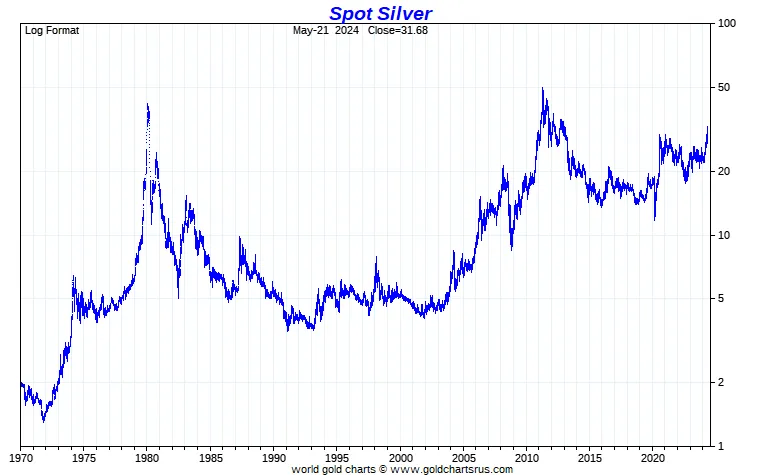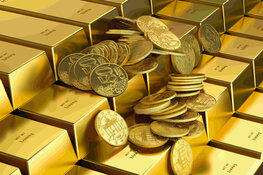Two things before we start:
-
I am going to the Edinburgh Fringe this August to do one of my "lectures with funny bits." This one is all about the history of mining. It's called Shaping the Earth. As always, I shall be delivering it at Panmure House, where Adam Smith wrote Wealth of Nations. It's at 2 pm most afternoons. Please come. Tickets here.
-
My first book and many readers' favorite, Life After the State — Why We Don't Need Government (2013), is now back in print — with the audiobook here: Audible UK, Audible U.S., and Apple Books. I recommend the audiobook ;)
So to the metal of the moon.

I must confess I am in two minds about silver.
On the one hand, this move above $30/oz is long overdue. $50/oz is coming into view. And if silver goes north of $50/oz — and one day it will — then the sky really is the limit.
On the other hand, it's silver. If there is one thing you can count on in the cruel world, it is that silver will always let you down. The golden (haha) rule when investing in silver, and I speak from experience, is not to get your hopes up. Silver has been disappointing its champions since 1873, when America's Coinage Act, known "the crime of 1873", got rid of the standard silver dollar altogether and with it bimetallism.
Silver's currently so overbought, and there is so much excitement about it, perhaps we should short the thing. Beware the RSI.

We will start with a brief overview of silver - both its potential and its propensity to disappoint. Then, I'll suggest some ways to invest. Spool down to the bottom if you want my pick of the small caps: this one really has potential and is one of my biggest positions.
A Quick Bit of Silver History That I Bet You Didn’t Know
As one of the seven native metals, metals that can be found in nature in pure form, human beings have been using silver since the dawn of civilization and probably before. Its first use was as jewelry. Its next was money. Silver shekels (about ¼ ounce) were currency in Ancient Mesopotamia, long before the invention of coinage. The words silver and money — argent in French, plata in Spanish — are interchangeable in numerous languages, ancient and modern.
Silver even has its own planet, the moon, and its own day of the week, Monday.
Silver's use as money started to die after the gold rushes of the 19th century dramatically increased world gold supply, so that by 1900 every major nation in the world, except China, was on a gold standard. Bimetallism was a thing of the past. With silver no longer money, demand for it fell, despite the fact that it probably has more applications than any other metal. The price has mostly struggled ever since.
There is roughly 15 times as much silver in the earth's crust as there is gold, so the natural ratio between the two should be 15 or thereabouts, and the historical ratio between the two was always in that 12-18 area. In other words, 15 silver coins would get you a gold coin of the same weight. However, so undervalued has silver become that over the last five years, that ratio has averaged between 80 and 90. At one point during Covid, it went to 125.
Today, even after the amazing run silver has had, it is at 75.

Despite the perennial disappointment of the silver price, every now and then, it moonshots — and returns to its rightful place in the sky. It went from below $5/oz in 1978 to $50/oz in 1980, followed by 20 years of disappointment.
It went from below $8/oz in 2008 to $50/oz in 2011. There then followed another 13 years of disappointment.
But those moonshots were very brief. You had a day or two to get out.
Are we midway through another moonshot? It is very possible.
Let's just say the gold price stays where it is around $2,400. I happen to think it is going higher, but let's just say it stays where it is, and the silver-gold ratio goes to 55, where it averaged for most of the noughties. Then, the silver price would have to be $43/oz. It's $32/oz today.
Let's just say the ratio goes back to 31, where it touched in 2011. Then silver goes to $77/oz.
Here's the thing: there is an argument - and a strong one - that the silver-gold ratio should actually be lower than the natural ratio of 15 because, while all the gold that has ever been mined still remains, the silver has been used and consumed. It's no longer there. So, there is less silver per ounce of gold than there previously was. At a ratio of 15, the silver price goes into the hundreds of dollars. And that's all without the gold price moving. What effects do these kinds of price rises have on the profits of silver miners?
It may seem like fantasy, but these kinds of narratives gain traction in bull markets, especially around silver, which has a lot of love and support among investors. In the U.S., in particular, there is a special fondness for silver amongst patriots and traditionalists, and bull markets ignite those sentiments.

Silver's Uses Today
Silver is to modern technology as sugar and salt are to modern food: it is in everything. It is almost harder to find things that don't contain silver than things that do. Every smartphone has silver in it, every computer, every jet engine, and every solar panel. The best batteries contain silver; it's used in detergent, deodorant, wart treatment, antimicrobial lab coats, 3D printing, plastics, jewelry, wood preservation, and water purification.
It's like a "picks-and-shovels" play on new tech and the growing middle class of the developing world. It is often associated with magic in folklore, but its properties are so varied and widespread that there really is something magical about it. Because it has so many industrial uses, it is something of a mystery why the silver price has been so low for so long. Some blame dark forces, others blame market forces, but since the demonetization of the late 19th century, the words silver and price suppression have commonly been uttered in the same sentence. Conspiracy or not, there is not a lot you or I can do about it, so we just have to accept the market for what it is.
Despite my long-documented ambivalence towards silver — I've gone from being a full-on, silver-fixes-this-and-saves-the-world bug to an unwelcome cynic - I still own physical metal, and I have an oversized position in a Mexican silver development play that will, I hope, turn producer as soon as this year. I'll tell you about that in a moment.
How To Invest in Silver
Broadly speaking, these are the four ways to get exposure to the silver price:
- Buy silver bullion — coins and bars
- Buy a silver ETF
- Buy silver via a spread bet, CFD, or a future
- Buy a silver mining company
If it's bullion you want, try the Pure Gold Company and tell them I sent you. (They deliver worldwide or you can store with them).
If you have the time and the inclination, you can often pick up antique silver, especially Georgian silver tea sets, on eBay and elsewhere at prices below the spot value of the silver content.
Exchange Traded Funds (ETFs) are simple and cheap. You buy them through your broker just as you would any share. New York-listed SLV is the biggest. For UK investors there are the WisdomTree Physical Silver ETFs (PHSP.L and PHAG.L). PHSP is denominated in pounds, so it will save you forex charges (unless you have dollars you are looking to invest). The Invesco Physical Silver ETC (SLVP) is another pound-denominated option, and iShares' ISLN is dollar-denominated.
There are also two- and three-times leveraged ETFs — caveat Emptor. If you know what you are doing, these can be good vehicles, but the costs can be quite high if you hold them for a long time. WisdomTree has a range, both long and short, and 3LSI.L is the ticker for the pound-denominated 3x option.
While on the subject of caveat emptor, there is also the CFD and spread bet option. If the market moves in your favor, they can be very rewarding, but you can also lose a great deal more than your initial stake. Be sure to manage your risk, i.e., have an exit if the market goes against you - and keep your position sizes manageable. The most common mistake is to make position sizes too big.
So to the Miners — And Own Play on the Sector
Finally, the gold and silver miners are starting to move. Exciting times. It has been a long wait.
The simplest way to buy silver mining companies, again, is via an ETF which tracks a basket of them.
Listed in both London and New York, both dollar-denominated, the GlobalX Silver Mining ETF (SIL.NYSE, SILG.L) is one option. The iShares MSCI Global Silver Miners ETF (SLVP.NYSE) is another. And if you want to get really spicy, there's the U.S.-listed ETFMG Prime Junior Silver Miners ETF (SILJ.NYSE), which tracks the small caps.
Fresnillo (FRES.L) and Hochschild (HOC.L) are the two biggest London-listed pure silver plays.
My picks of the large caps are SilverCrest Metals Inc. (SIL:TSX.V; SILV:NYSE.American), Pan American Silver Corp. (PAAS:TSX; PAAS:NASDAQ), MAG Silver Corp. (MAG:TSX; MAG:NYSE American), and First Majestic Silver Corp. (FR:TSX; AG:NYSE; FMV:FSE), run by my buddy Keith Neumeyer, for which I have a very soft spot. It also has a bullion shop.
So, to my pick of the juniors
I think this company has real potential.
If you'd like to read more from Dominic, you can sign up for The Flying Frisby here.
| Want to be the first to know about interesting Silver investment ideas? Sign up to receive the FREE Streetwise Reports' newsletter. | Subscribe |
Important Disclosures:
- Mag Silver Corp. is a billboard sponsor of Streetwise Reports and pays SWR a monthly sponsorship fee between US$4,000 and US$5,000.
- As of the date of this article, officers and/or employees of Streetwise Reports LLC (including members of their household) own securities of Pan American Silver Corp.
- Dominic Frisby: I, or members of my immediate household or family, own securities of: SM.v. I determined which companies would be included in this article based on my research and understanding of the sector.
- Statements and opinions expressed are the opinions of the author and not of Streetwise Reports, Street Smart, or their officers. The author is wholly responsible for the accuracy of the statements. Streetwise Reports was not paid by the author to publish or syndicate this article. Streetwise Reports requires contributing authors to disclose any shareholdings in, or economic relationships with, companies that they write about. Any disclosures from the author can be found below. Streetwise Reports relies upon the authors to accurately provide this information and Streetwise Reports has no means of verifying its accuracy.
- This article does not constitute investment advice and is not a solicitation for any investment. Streetwise Reports does not render general or specific investment advice and the information on Streetwise Reports should not be considered a recommendation to buy or sell any security. Each reader is encouraged to consult with his or her personal financial adviser and perform their own comprehensive investment research. By opening this page, each reader accepts and agrees to Streetwise Reports' terms of use and full legal disclaimer. Streetwise Reports does not endorse or recommend the business, products, services or securities of any company.
For additional disclosures, please click here.
Dominic Frisby Disclosures: This letter is not regulated by the FCA or any other body as a financial advisor, so anything you read above does not constitute regulated financial advice. It is an expression of opinion only. Please do your own due diligence and if in any doubt consult with a financial advisor. Markets go down as well as up, especially junior resource stocks. We do not know your personal financial circumstances, only you do. Never speculate with money you can’t afford to lose.





































